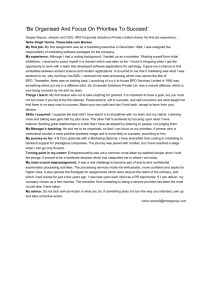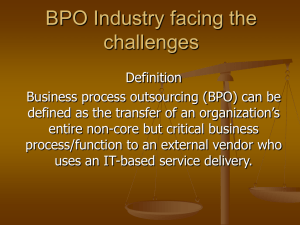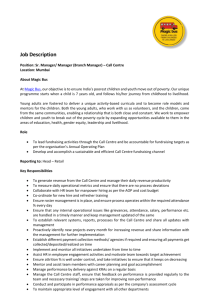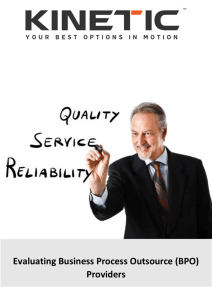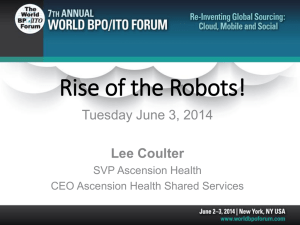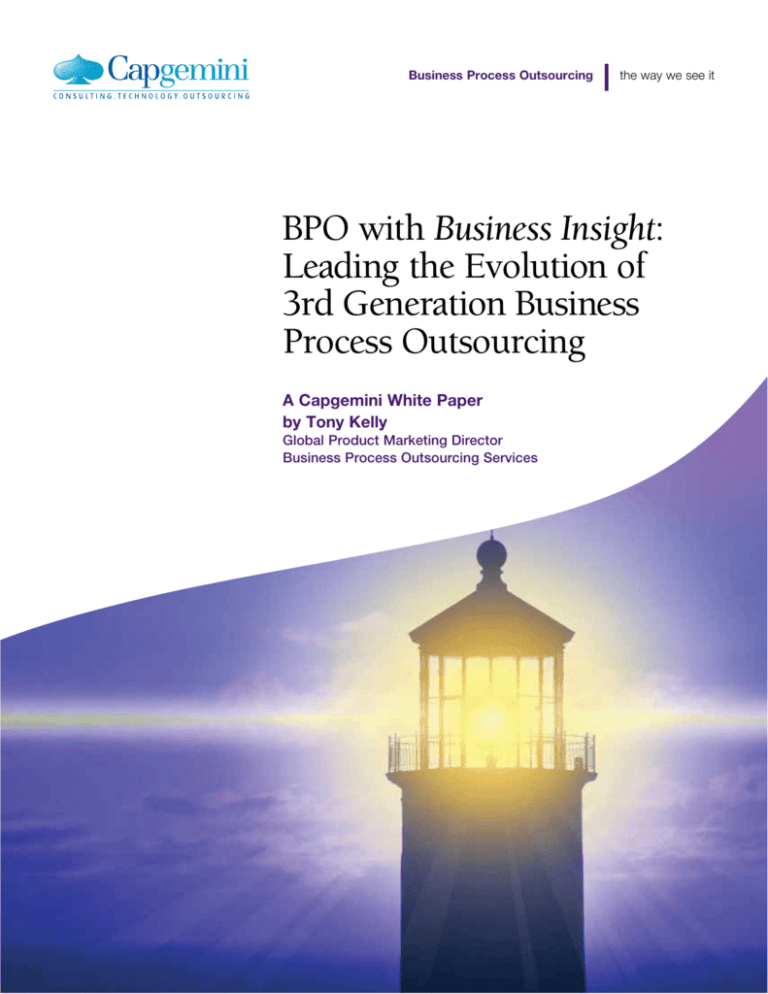
Business Process Outsourcing
the way we see it
BPO with Business Insight:
Leading the Evolution of
3rd Generation Business
Process Outsourcing
A Capgemini White Paper
by Tony Kelly
Global Product Marketing Director
Business Process Outsourcing Services
Contents
Executive Summary
01
1 3rd Generation BPO: The Next Evolution of the BPO Market
02
2 3rd Generation BPO: Value Added Services for the Top and Bottom Lines
03
3 Case Study: A Utility Company Leverages BPO with Business Insight
and Gains Top Line Value through Customer Retention
05
4 Delivering Top Line Benefits from a Bottom-line Focused Business Model
06
5 Business Insight: Turning Business Intelligence into Action
07
6 Maturity and Readiness
08
7 Contracting for BPO with Business Insight
09
8 Conclusion
10
Business Process Outsourcing
the way we see it
Executive Summary
The 3rd Generation of Business Process Outsourcing (BPO) services has arrived. It is
focused on increased value add, innovative solution architectures and much closer
partnerships between clients and service providers. Capgemini is leading 3rd
Generation BPO providers in collaborating with clients to improve the top line,
while still delivering conventional BPO support that benefits the bottom line.
Third Generation BPO is a natural evolution in the BPO market as both the supply
side and buy side mature and seek new, innovative thinking as well as new product
and service offers. First Generation BPO was largely a labor arbitrage model
characterised by a lift and shift delivery approach. This was quickly superseded by
2nd Generation BPO, which moved beyond shared services in lower cost locations,
and began to focus on continuous improvement. Continuous improvement
initiatives lasted nearly a decade, and remain the industry standard within BPO
offerings. However, progressive service providers and innovative clients are looking
beyond continuous improvement and bottom-line focus to find ways to create value
for the top line. This is leading to more collaborative relationships between clients
and providers.
Other elements of 3rd Generation BPO influence service delivery, such as the
increased use of Service Oriented Architecture (SOA) in delivery models and more
sophisticated and technical point solutions, as well the shifting relationship between
captive shared service centers and BPO models. While these topics are important,
the focus of this paper is on one key differentiator of 3rd Generation BPO: the
creation of services to address the top line of the client’s business. Capgemini’s
approach in this area is unique: BPO with Business Insight.
This fundamental leap forward is the recognition that what was previously seen as
just workflow (i.e. the large volumes of transaction processing data inherent in most
conventional BPO delivery models), in many cases, is actually a rich seam of value
that can be mined to extract hidden benefits. Most importantly, the mining of this
value, using Business Insight processes with business intelligence tools, can drive top
line benefits. For example, the resulting analysis could be used to support revenue
recovery or improved customer service.
Conventional, bottom-line focused BPO processing excellence is the starting point
and is the foundation of BPO services. But progressive organizations will increasingly
seek services that extract additional value. In a later section, this paper describes an
example of a utility company where disparate BPO workflows are brought together
to provide a rich mix of data that paints a picture of customer behavior. Capgemini’s
unique Business Insight processes enable segmentation of the customer base and the
ability to predict which customers are likely to switch to a competitive service
provider and when that is likely to occur. The resulting Business Insight positively
affects the top line through customer retention.
The provision of BPO with Business Insight requires a complex set of capabilities and
competencies, combining deep industry domain knowledge, unique processes using
business intelligence tools, and finally, the ability to close the loop and industrialize
the new processes into ongoing day-to-day operations. This level of competency is
Business Process Outsourcing with Business Insight
1
only available from service providers with a long and successful track record in the
industry. Typically, this is beyond the reach of the commodity provider since it
requires investment and focus to build deep industry and sector-specific expertise
along with the routine BPO processing skills.
Client maturity and the client’s business objectives will clearly influence the adoption
of 3rd Generation BPO. Since these value adding services cannot be provided
without investment, it is necessary to develop the contractual relationship in a way
that reflects those objectives. Contracts that are focused only on short-term cost
savings will not provide the flexibility to realize the more significant, long term
benefits of combining top and bottom line improvement strategies.
The demand for basic 2nd Generation, bottom-line focused BPO will not go away –
indeed, the bulk of the market demand is likely to remain in this area. The leading
BPO vendors cannot ignore the basics and must maintain excellence and world class
competence in these fundamentals. Forward-thinking clients will increasingly engage
with the service provider who can manage the transition to stable and effective
processing – providing optimal bottom-line BPO services with continuous
improvement – while also creating the conditions to achieve a competitive advantage
on the top line via BPO with Business Insight.
1. 3rd Generation BPO: The Next Evolution of the
BPO Market
The BPO services market has a 15-year track record of evolution. The simple shared
services model gave way to a sourcing decision to buy externally. The outsourcer’s
value proposition was providing the same services, but at a lower cost. Inevitably, the
competitive environment drove the leading vendors to innovate and continuously
improve their service offerings. The value proposition has also developed to match the
accelerating demands of the buy side, which is under increasing price and globalization
pressures.
The evolution of business process outsourcing during the last 15 years can be
characterized in three phases or generations.
Capgemini: A History of Innovation
2
Business Process Outsourcing
the way we see it
1st Generation BPO – Lift and Shift
Through the mid ‘90s, the BPO proposition was largely focused on consolidation
into a shared service center with labor arbitrage on the transaction processing.
The primary objective was to simply reduce cost. Sometimes this has been crudely
described as my mess for less. Clearly, as a service proposition this model was not
going to last long without demands for greater value. Nevertheless, there are still
providers in the market operating at this end of the spectrum.
2nd Generation BPO – Continuous Improvement
By the end of the ‘90s, the basic requirements for a competitive service had evolved.
Fundamental transaction processing and labor arbitrage were still essentials, but
delivery models were maturing, process expertise was deepening and new technologies
were emerging to provide point solution support, such as sophisticated Optical
Character Recognition (OCR) scanning engines. This 2nd Generation can be
described as the era of Continuous Improvement.
Key service provider capabilities included the ability to transition complex processes
into low cost locations, while providing process re-engineering, improvements in
productivity and quality, as well as incremental gains on a continuous basis. During
this period, work scopes also expanded from task-focused projects to full-scope
services in single towers such as Finance and Accounting (F&A). Consequently,
service providers now must operate in an increasingly specialized market. Maturity
of services development has matched confidence in the buy side, prompting clients
to hand over more complex processes.
Such complex projects might include multiple processes, multiple languages and
more often than not, multiple instances of a primary Enterprise Resource Planning
(ERP) package, such as SAP, alongside other legacy ERP systems. In a contemporary
multi-national BPO project, it is not unusual to find a legacy integration of SAP,
Oracle, PeopleSoft and Microsoft spreadsheets and more, distributed across more
than 20 countries and 20 languages. Few vendors can successfully deliver these
services and achieve continuous improvement at this level of complexity.
2. 3rd Generation BPO: Value Added Services for the
Top and Bottom Lines
More and more organizations now see the BPO services model as a way to both
improve operational performance and create competitive advantage through
processing excellence. Second Generation BPO, which focused on delivering bottomline efficiencies, is becoming an essential and stable component of efficiently
operating global corporations. The leaders in BPO services will continue to improve
and refine the basic BPO model to deliver greater value to the bottom line.
Innovative thought leaders in the BPO services market, such as Capgemini, are
already developing a much broader service. This includes the delivery of
improvements to both the top line and the bottom line of the client’s business. Both
halves of the supply/demand equation are driving this evolution. The buy side has
an insatiable appetite for efficiency and effectiveness, while the supply side is
operating in an increasingly competitive market where there is rapidly developing
polarization between service providers. On the one side there are providers who are
focused on commodity services, while the market leaders add top-line value in
addition to process excellence and bottom-line savings.
Business Process Outsourcing with Business Insight
3
BPO with Business Insight: Improving the Top and Bottom Lines
Other facets of 3rd Generation BPO include technology developments in delivery
support, more sophisticated point solutions, increasing use of automation, and trends
such as Software as a Service (SaaS). But these areas are topics in their own right and
will not be addressed in this paper. Many of these features are maturing aspects of
existing trends. Over time, labor arbitrage is a steadily eroding advantage and
technical solutions and tools can be purchased by anyone. The forward-thinking BPO
service provider understands that the balance needed is the ability to provide clients
with competitive advantage as well as operational efficiency. Plus, they must be able
to do this in a way that delivers a tailored front end solution while exploiting the best
and optimal practices from industrialization and standardization. In this paper we will
concentrate on the added value associated with mining value from basic BPO
workflow.
The ability to deliver positive impact to the top line of the client’s business, as well
as fulfill all the basics of continuous improvement for the bottom line, is the essence
of 3rd Generation BPO. Capgemini calls this BPO with Business Insight.
A key facet of 3rd Generation BPO is the recognition that there is a twin opportunity
when processes are transitioned to a service provider. The first is the opportunity to
improve the processes, reduce the operating costs, relocate, re-engineer and deliver
productivity and quality with continuous improvement. These improvements are
largely bottom-line focused. The second is to recognize that the BPO provider is
agglomerating disparate and often previously unconnected data – often from different
client departments – during the service provision. These transaction volumes hold a
potential seam of value that can be analyzed to extract benefit for the top line.
4
Business Process Outsourcing
the way we see it
3. Case Study
A Utility Company Leverages BPO with Business Insight and Gains
Top-line Value through Customer Retention
In the energy and utilities market, and in other markets such as telecommunications
and financial services, customers have multiple service providers to choose from.
The potential for switching to another provider, sometimes known as customer
churn, is significant. When a customer has a poor experience, he or she may elect to
switch to another provider. The company will lose a customer and the associated
revenue stream. With millions of customers, the commercial risk is enormous. This
large utility company was having customer- and product-loyalty issues, resulting in
churn and increased customer support and service costs.
Business Insight: Affecting the Top Line for a Large Utility Company
As a BPO service provider to this client, Capgemini already handled a significant
portion of the more complex queues of the company’s inbound call center traffic and
also provided back office services for billing, F&A and revenue management.
Capgemini had access through our Customer Care & Intelligence BPO services to
the whole customer experience via the call logs, as well as the payments record,
billing data, and other customer interactions. This put Capgemini in a position to
unlock the value of that data.
Capgemini built a tailored process combined with a business intelligence tool to
analyze the hidden value in the data. We could therefore take the final step of
turning this business intelligence into action by closing the loop on the Business
Insight process. Our analysis enabled us to segment the customer base and predict
which segments were likely to churn and when. We then worked with the client to
refine the upstream experience and handling of the customer. Typically, this
approach may take the form of modifications to the inbound call handling process,
but it may also drive the client to make modifications to its products and services,
such as simplification of a payment plan and other customer-facing processes.
Business Process Outsourcing with Business Insight
5
With Capgemini’s predictive analysis of the customer lifecycle as a foundation,
the utility company was able to increase customer loyalty and reduce churn by
improving transaction handling time and enhancing the customer contact
experience, while also decreasing customer service costs.
This case is a prime example of how organizations can harness the benefits of BPO
for both bottom-line and top-line value, resulting in measurable return on
investment (ROI). Since one percent on the revenue stream has a much greater
overall impact than one percent savings off the bottom line, organizations can
achieve excellent ROI by applying this unique BPO approach.
4. Delivering Top Line Benefits from a Bottom-line
Focused Business Model
Organizations must first understand that BPO with Business Insight is not a typical
consulting project, a single exercise, or a report. Capgemini’s BPO services model
goes beyond traditional services to ensure the long-term delivery of client benefits.
BPO with Business Insight is an operational activity. It is proactive and not a passive
report, delivered through a combination of operational expertise and collaboration
with the client.
Business Insight Components
A key facet of Capgemini’s approach to BPO delivery is the recognition that one size
does not fit all. This means that some tailoring to suit the individual characteristics of
each client is essential, along with an industrialized approach to a continuous
improvement throughout the life of the contract. The ability to deliver Business Insight
is beyond the reach of basic BPO service providers.
This tailored approach with the economic advantages of process standardization
and a more industrialized delivery addresses both client-specific needs and
economies of scale.
6
Business Process Outsourcing
the way we see it
Implementing business intelligence processes to deliver value to the top line and
then following through by industrializing the process into ongoing day-to-day
operations requires a deep understanding of both the client’s processes and the
client’s business environment. Consequently Business Insight delivery capability
comes from a combination of:
Deep industry domain knowledge
Broad process expertise
O Benchmarking capabilities
O Business intelligence tools and business analytics competency
O Methodologies and global infrastructure to industrialize the insight into day-to-day
operations
O
O
5. Business Insight: Turning Business Intelligence
into Action
It is important to grasp the major step between business intelligence and Business
Insight. There are many providers of good business intelligence tools and there are
even BPO service providers that offer access to these tools with the service. But this
is analogous to giving someone a stethoscope and scalpel and expecting they can
perform surgery.
Business Insight: Turning Business Intelligence into Action
The two key requirements are that a) the data should be in a position to be worked
upon – i.e. stable and accurate – and b) the operatives doing the analysis must be
deeply knowledgeable in the process and the client’s business.
BPO service providers have an advantage over business intelligence tools suppliers and
external consultants. BPO providers already manage the transaction volumes and have
the operational processing expertise and familiarity with the day-to-day traffic flows
and content. This means the re-engineering and data cleansing will have already taken
place, thus ensuring the stability, consistency and accuracy needed for the Business
Insight analytics to have impact.
Business Process Outsourcing with Business Insight
7
The BPO practitioner brings not only the business intelligence tool, but also a level
of knowledge from thousands of man-years of industry expertise. When combined
with process expertise and access to the combined data sets, this provides an
unprecedented combination of excellence in processing the workflow and also in
analyzing the content of the workflow to release the hidden value.
The final key comes by moving from business intelligence to Business Insight. This is
the difference between being informed (being provided with business intelligence)
and being enabled (closing the loop by taking the output from the business
intelligence and analyzing it in the context of the client’s operations and business).
This allows the service provider and client to work much more collaboratively and
act upon the information to implement remedial works, process changes and
additions. In some cases, client product changes will need to be made to prevent a
poor service or process issue from reoccurring or to make improvements to benefit
sales.
The Business Insight process starts with the transaction volume in the day-to-day BPO
workflow processes and builds visibility, often involving agglomeration across
disparate data sets. This action is supported by a unique process that uses business
intelligence tools to extract and analyze the value in the data to unlock the potential
benefit from the workflow. The result: Business Insight is delivered to the client by
closing the loop to the top line.
6. Maturity and Readiness
Not all businesses will be ready for 3rd Generation BPO on day one of a BPO service.
For most, their processes will not be stable enough and the transparency into
transaction volumes will be insufficient to provide adequate benchmarking for the
application of Business Insight processes.
Key Conditions for Business Insight Development
8
Business Process Outsourcing
the way we see it
Therefore, organizations should expect their BPO service provider to offer assessment
and readiness support. Rigorous transition programs, process efficiency models and
continuous improvement methodologies will help produce the stability, effectiveness
and efficiency associated with excellence in 2nd Generation BPO. This will create the
potential for further exploitation via Business Insight processes which are part of 3rd
Generation BPO. Irrespective of client readiness or maturity, there is the issue of the
client’s business objectives. The BPO service must be tailored to the client’s objectives
and there will always be those whose primary goal is simply operational cost-cutting.
In such cases, a focus on bottom-line improvement is sufficient.
The BPO service provider will need to make significant investments to deliver these
additional top-line focused innovations. It is, therefore, essential that two key criteria
be in place before committing to BPO with Business Insight. As discussed above, the
data must be in a robust, measurable and stable enough condition for the Business
Insight analysis. The second key criteria is that the client’s business objectives and the
service provider’s objectives must be aligned. The primary resource that fuels
innovation and Business Insight is the workflow volume of conventional BPO services.
Investment will be required, so the contract will need to reflect this in the business plan.
Capgemini’s BPO Solution Portfolio
7. Contracting for BPO with Business Insight
BPO with Business Insight may not always be appropriate for the client at the start of
a project. As stated earlier, the scope of the services are influenced by maturity of the
client’s business and processes and also the client’s business objectives. In some
cases, for example, over a seven-year BPO contract, client readiness may only be
possible after a number of years into the project. Consequently, the contract needs
to be constructed in a way that is flexible enough to accommodate expected
maturation. The provision of BPO with Business Insight requires the service provider
to invest in innovation, which includes highly-skilled industry- and domainknowledgeable staff who are also process experts in the client’s field. In addition,
investments in business intelligence tools and other infrastructure may be necessary.
This means it’s essential that the business case for investment works for both the
client and the service provider.
Business Process Outsourcing with Business Insight
9
Innovation has a price tag. Driving the cost down to an absolute minimum at project
onset may result in the biggest possible cost reduction in the short term, but is more
likely to result in missed business gain later in the contract.
Taking the long-term view of ROI into account, it is more likely that building in
business benefit to the top line through Business Insight will take the form of a
collaborative approach between service provider and client. Therefore, a shared riskand-reward pricing strategy will reflect a partnering style and deliver the appropriate
behavior from both parties. The BPO provider commits to top line key performance
indicators (KPIs) for the client. This is only possible in cases where the transaction
volume under management is the right data to create the potential value and is stable
enough to support analysis. In addition, the client must be committed to allow the
service provider to influence the business outcome. A shared risk-and-reward pricing
model is the best way to support such an outcome. The benefits of this closer
working relationship can be significant. BPO with Business Insight does require a
much greater level of intimacy between service provider and client, but with the
additional benefit of greater ROI.
8. Conclusion
Third Generation BPO is a natural evolution of the BPO market as both the buy side
and services side reach a new level of maturity. Extracting value from BPO workflow
through Business Insight to benefit the top line is one of the leading components of
3rd Generation BPO.
These 3rd Generation developments are accelerating the polarization of the BPO
service provider market into those at the top end of the value chain and those
focused on commodity service provision. The resulting inflection point created by
this polarization marks the start of the new area of 3rd Generation BPO.
The level of capability, defined by the depth and breadth of domain expertise will
continue to drive further polarization in the BPO services market. This depth and
breadth, combined with the transformational expertise to industrialize Business Insight
into day-to-day operations, demands a successful track record in the BPO industry
and investment in sector-specific expertise that is typically beyond the reach of the
commodity BPO player.
However, the demand for the basics of 2nd Generation bottom-line focused BPO will
not go away – indeed, the bulk of the market demand is likely to remain in this area.
The leading BPO vendors cannot ignore the basics and must maintain excellence and
world class competence in these fundamentals. The enlightened client will increasingly
look to the future and engage the service provider who has fully embraced 3rd
Generation BPO. This will provide optimal bottom-line BPO services with
continuous improvement while also creating the necessary conditions to achieve a
competitive advantage on the top line via BPO with Business Insight.
To learn more about BPO with Business Insight from Capgemini, please visit
www.capgemini.com/bpo.
Copyright © 2007 Capgemini. All rights reserved.
10
www.capgemini.com/bpo
About Capgemini and the
Collaborative Business Experience
Capgemini, one of the
world’s foremost providers of
Consulting, Technology and Outsourcing
services, has a unique way of working
with its clients, called the Collaborative
Business Experience.
focused methods and tools. Through
commitment to mutual success and the
achievement of tangible value, we help
businesses implement growth strategies,
leverage technology, and thrive through
the power of collaboration.
Backed by over three decades of industry
and service experience, the Collaborative
Business Experience is designed to help
our clients achieve better, faster, more
sustainable results through seamless
access to our network of world-leading
technology partners and collaboration-
Capgemini employs more than 80,000
people worldwide and reported 2006
global revenues of 7.7 billion euros.
North America
Claude Hartridge
+1 (678) 488 8295
claude.hartridge@capgemini.com
Europe
Carina Smith
+44 (870) 366 0882
carina.smith@capgemini.co.uk
Asia/Pacific
Aurore Saglio
+852 (31) 12 33 48
aurore.saglio@capgemini.com
More information about our services,
offices and research is available at
www.capgemini.com.



